Thursday, Feb. 25, a group of students assembled outside the Alumni House at the College of William and Mary to advocate for the updating of memorial names across campus. The protest took place during a recess on the Board of Visitors first day of meeting, after a last-minute schedule change canceled a student panel dedicated to discussing race issues across campus.
The student protest began their chants half an hour before the Board’s Committee on Student Experience was set to meet with representatives from the Student Assembly about race-related campus issues. The meeting and protest came on the heels of the SA-mediated, campus-wide referendum on practices for renaming the College’s buildings and statues.
The referendum and the protest marked the latest points in the contention over how far the College should go in renaming buildings, campus landmarks and awards that bear the legacies of people associated with slavery and segregation. In September, the College renamed two buildings: Maury and Trinkle Halls, now known as York River Hall and Unity Hall.
Now, the renaming commission is considering doing the same action for several buildings across campus; however, some students have criticized the measures as not going far enough.
That contention has been especially pronounced when centered on prominent alumni, such as Thomas Jefferson and James Monroe, who were slaveowners. The referendum presented students with a derogatory anonymized quote from Thomas Jefferson, of which a majority of respondents expressed disapproval.
In SA’s statement that accompanied the referendum’s results, the body criticized the administration’s position of excepting the Founding Fathers from the renaming evaluation process, as laid out in the College’s renaming guidelines.
SA’s comments strike a contrast with the statement of College Rector John Littel last September defending the continuous representation of these names across campus.
“While it is our responsibility to contextualize these individuals and add to the history already here, it is incumbent upon all of us to recognize that there would be no William and Mary and, indeed no United States of America, without these individuals,” Littel said.
Leaders of the protest yelled out racist quotes from men whose names are affixed to campus buildings, such as Lyon Gardiner Tyler, the son of U.S. President John Tyler, who served as president of the College from 1888 to 1919. Tyler was an outspoken critic of Abraham Lincoln and defender of the Confederacy. Then the crowd began to chant “change the names” in the direction of the Alumni House.
Yannira Lopez-Perez ’22 was one of the primary speakers at the protest.
“The BOV upholds white supremacy, we have to acknowledge that,” Lopez-Perez shouted to the crowd through a megaphone. “They don’t care about any of us. But they especially don’t care about their Black students.”
“The BOV upholds white supremacy, we have to acknowledge that,” Lopez-Perez shouted to the crowd through a megaphone. “They don’t care about any of us. But they especially don’t care about their Black students.”
As the crowd applauded Lopez-Perez, the speakers were pushed back about 50 feet by administators at the meeting, due to a state restriction on noisemaking devices near places of work. Later, when a figure appeared in a second-floor window, the protesters directed their chants there for a time.
Protest attendee Janelle Krupicka ’24 said she was there to support the SA referendum and the initiative that it represents.
“I’m hoping that the Board of Visitors will support the referendum by the Student Assembly to rename buildings on campus according to what students want,” Krupicka said.
Krupicka added that she supported a blanket ban on any building or statue commemorating a slaveowner, singling out the College’s statue of Thomas Jefferson.
“Taking those down is something that would be important to me and to a lot of other students,” Krupicka said.
Salimata Sanfo ’22, a primary organizer of the protest, said that she thought the protest would put pressure on the Board to take action on the building renaming issue.
“It’ll show the urgency,” Sanfo said. “I don’t think you can push this back anymore. I don’t want any more long conversations. I want them to see how much students really care about this issue, and see the urgency and the passion.”
“It’ll show the urgency,” Sanfo said. “I don’t think you can push this back anymore. I don’t want any more long conversations. I want them to see how much students really care about this issue, and see the urgency and the passion.”
Krupicka spoke on the importance of the alumni’s reaction and the intricacies behind the process of renaming.
“I think a lot … will depend on the alumni reaction to the event and to the renaming in general,” Krupicka said. “I’m not sure that just student activism independently will be enough to get the Board of Visitors to listen, but I’m hoping that a collective action could lead to more renaming.”
Hunter Hall, where the Board of Visitors met, was at its COVID-reduced capacity by the time of the protest, so the students outside were not admitted to watch the meeting in person. However, administrative staff distributed a flyer giving those present the phone number to dial in and listen to the session.
The atmosphere in the session of the Board of Visitors, which began inside the Alumni House just as the protest ended, was much more subdued in comparison.
The meeting consisted of representatives of the Student Assembly and various SA committees speaking to the Board and fielding questions from Board members about broader issues of campus diversity.
The SA representatives discussed with the Board ideas for promoting racial inclusion and multiculturalism within the College’s curriculum. However, though it was the highlight of the events outside, the renaming issue was not explicitly discussed by the panel inside, and the Board of Visitors session was given over entirely to discussion, rather than any formal vote.

